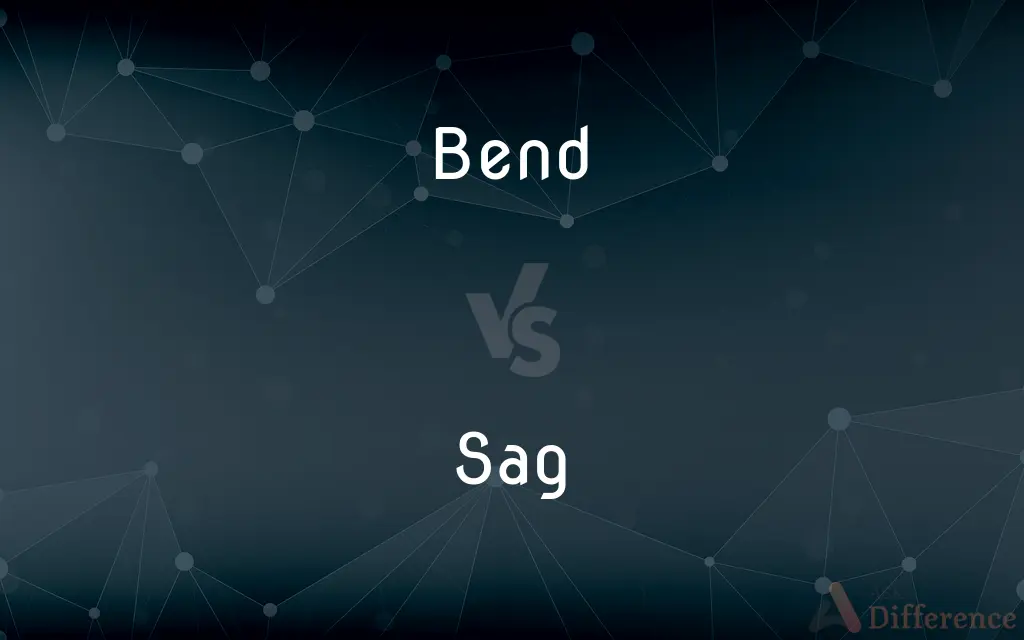Bend vs. Sag — What's the Difference?
By Urooj Arif & Fiza Rafique — Updated on April 4, 2024
Bend refers to a curve or angle formed by altering a straight form, focusing on intentional shaping, while sag emphasizes a downward droop due to weight or weakness, often unintended.

Difference Between Bend and Sag
Table of Contents
ADVERTISEMENT
Key Differences
Bend involves the action of shaping something from a straight line into a curve or angle, implying an intentional force or adjustment. Whereas, sag describes the action or result of sinking or drooping downwards, typically under the influence of gravity or due to lack of support, suggesting an unintentional or natural consequence.
When materials or objects bend, they usually maintain their new form unless acted upon by another force, highlighting the durability or flexibility of the material. On the other hand, sagging often indicates a temporary or progressive state of decline or weakening, where the object may continue to droop further unless supported or repaired.
Bending can be a desired process in various applications, such as construction, art, and manufacturing, where the shape of materials is altered for specific purposes. Conversely, sagging is generally viewed as undesirable, signaling failure, wear, or structural issues that may require correction.
In terms of observation, a bend in an object is often a permanent feature, deliberately introduced and serving a specific function or aesthetic. Sag, however, is typically an indication of distress or damage, observed as a deviation from an object's intended form or structure.
The terminology also diverges in its usage context; bending is commonly associated with active processes and design, such as bending a wire or shaping a piece of wood. Sagging, conversely, is associated with passive scenarios, often resulting from external pressures or internal failures, such as a sagging floor or a drooping shelf.
ADVERTISEMENT
Comparison Chart
Definition
The act or result of curving or angling something from a straight line.
The act or result of drooping or sinking downward.
Intentionality
Often intentional, with a purposeful force applied.
Generally unintentional, due to external pressures or weakness.
Resulting Shape
Produces a defined curve or angle, usually permanent.
Results in a downward droop, often seen as a sign of wear or failure.
Context of Usage
Common in construction, art, and design for specific purposes.
Associated with structural or material failure needing correction.
Implication
Suggests flexibility or purposeful design.
Indicates a problem or defect, often requiring intervention.
Compare with Definitions
Bend
A deliberate change in direction or shape.
The artist bends the wire carefully to create a sculpture.
Sag
The act of drooping or sinking under weight.
The shelf began to sag under the weight of the books.
Bend
To shape something into a curve or angle.
He used a tool to bend the metal rod into a circle.
Sag
A downward curve resulting from weakness or pressure.
There's a noticeable sag in the middle of the old bridge.
Bend
The act of deviating from straightness.
The road begins to bend to the left near the hill.
Sag
An unintentional droop due to lack of support.
The mattress sagged in the center, making it uncomfortable to sleep on.
Bend
The result of applying force to alter shape.
The bend in the pipe was necessary for the plumbing to fit.
Sag
A problem often requiring correction or support.
Fixing the sag in the floorboards became his weekend project.
Bend
A feature introduced by altering a material's original straightness.
The bend in the book's spine indicated frequent use.
Sag
Indicative of wear, fatigue, or failure.
The sag in the roof suggested it might collapse soon.
Bend
To cause to assume a curved or angular shape
Bend a piece of iron into a horseshoe.
Sag
To sink, droop, or settle from pressure or weight.
Bend
To bring (a bow, for example) into a state of tension by drawing on a string or line.
Sag
To lose vigor, firmness, or resilience
My spirits sagged after I had been rejected for the job.
Bend
To force to assume a different direction or shape, according to one's own purpose
“Few will have the greatness to bend history itself, but each of us can work to change a small portion of events” (Robert F. Kennedy).
Sag
To decline, as in value or price
Stock prices sagged after a short rally.
Bend
To misrepresent; distort
Bend the truth.
Sag
(Nautical) To drift to leeward.
Bend
To relax or make an exception to
Bend a rule to allow more members into the club.
Sag
To wear one's pants with the waist below the hips, so that one's underwear is visible.
Bend
To cause to swerve from a straight line; deflect
Light is bent as it passes through water.
Sag
To cause to sag.
Bend
To render submissive; subdue
“[His] words so often bewitched crowds and bent them to his will” (W. Bruce Lincoln).
Sag
The act or an instance of sagging.
Bend
To apply (the mind) closely
“The weary naval officer goes to bed at night having bent his brain all day to a scheme of victory” (Jack Beatty).
Sag
The degree or extent to which something sags.
Bend
(Nautical) To fasten
Bend a mainsail onto the boom.
Sag
A sagging or drooping part or area
Tried to brush out the paint sags.
Bend
To deviate from a straight line or position
The lane bends to the right at the bridge.
Sag
A sunken area of land; a depression.
Bend
To assume a curved, crooked, or angular form or direction
The saplings bent in the wind.
Sag
A sagging area; a depression.
Bend
To incline the body; stoop.
Sag
A decline, as in monetary value.
Bend
To make a concession; yield.
Sag
(Nautical) A drift to leeward.
Bend
To apply oneself closely; concentrate
She bent to her task.
Sag
The state of sinking or bending; a droop.
Bend
The act or fact of bending.
Sag
The difference in elevation of a wire, cable, chain or rope suspended between two consecutive points.
Bend
The state of being bent.
Sag
The difference in height or depth between the vertex and the rim of a curved surface, specifically used for optical elements such as a mirror or lens.
Bend
Something bent
A bend in the road.
Sag
To sink, in the middle, by its weight or under applied pressure, below a horizontal line or plane.
A line or cable supported by its ends sags, even if it is tightly drawn.
The floor of a room sags.
Her once firm bosom began to sag in her thirties.
Bend
A knot that joins a rope to a rope or another object.
Sag
(by extension) To lean, give way, or settle from a vertical position.
A building may sag one way or another.
The door sags on its hinges.
Bend
Bends The thick planks in a ship's side; wales.
Sag
(figuratively) To lose firmness, elasticity, vigor, or a thriving state; to sink; to droop; to flag; to bend; to yield, as the mind or spirits, under the pressure of care, trouble, doubt, or the like; to be unsettled or unbalanced.
Bend
Bends (used with a sing. or pl. verb) Decompression sickness. Used with the.
Sag
To loiter in walking; to idle along; to drag or droop heavily.
Bend
A band passing from the upper dexter corner of an escutcheon to the lower sinister corner.
Sag
(transitive) To cause to bend or give way; to load.
Bend
(transitive) To cause (something) to change its shape into a curve, by physical force, chemical action, or any other means.
If you bend the pipe too far, it will break.
Don’t bend your knees.
Sag
(informal) To wear one's trousers so that their top is well below the waist.
Bend
(intransitive) To become curved.
Look at the trees bending in the wind.
Sag
To pull down someone else's pants.
Bend
(transitive) To cause to change direction.
Sag
To sink, in the middle, by its weight or under applied pressure, below a horizontal line or plane; as, a line or cable supported by its ends sags, though tightly drawn; the floor of a room sags; hence, to lean, give way, or settle from a vertical position; as, a building may sag one way or another; a door sags on its hinges.
Bend
(intransitive) To change direction.
The road bends to the right.
Sag
Fig.: To lose firmness or elasticity; to sink; to droop; to flag; to bend; to yield, as the mind or spirits, under the pressure of care, trouble, doubt, or the like; to be unsettled or unbalanced.
The mind I sway by, and the heart I bear,Shall never sag with doubt nor shake with fear.
Bend
(intransitive) To be inclined; to direct itself.
Sag
To loiter in walking; to idle along; to drag or droop heavily.
Bend
To stoop.
He bent down to pick up the pieces.
Sag
To cause to bend or give way; to load.
Bend
(intransitive) To bow in prayer, or in token of submission.
Sag
State of sinking or bending; sagging.
Bend
(transitive) To force to submit.
They bent me to their will.
Sag
A shape that sags;
There was a sag in the chair seat
Bend
(intransitive) To submit.
I am bending to my desire to eat junk food.
Sag
Droop, sink, or settle from or as if from pressure or loss of tautness
Bend
(transitive) To apply to a task or purpose.
He bent the company's resources to gaining market share.
Sag
Cause to sag;
The children sagged their bottoms down even more comfortably
Bend
(intransitive) To apply oneself to a task or purpose.
He bent to the goal of gaining market share.
Bend
(transitive) To adapt or interpret to for a purpose or beneficiary.
Bend
To tie, as in securing a line to a cleat; to shackle a chain to an anchor; make fast.
Bend the sail to the yard.
Bend
To smoothly change the pitch of a note.
You should bend the G slightly sharp in the next measure.
Bend
To swing the body when rowing.
Bend
A curve.
There's a sharp bend in the road ahead.
Bend
Any of the various knots which join the ends of two lines.
Bend
A severe condition caused by excessively quick decompression, causing bubbles of nitrogen to form in the blood; decompression sickness.
A diver who stays deep for too long must ascend very slowly in order to prevent the bends.
Bend
(heraldry) One of the honourable ordinaries formed by two diagonal lines drawn from the dexter chief to the sinister base; it generally occupies a fifth part of the shield if uncharged, but if charged one third.
Bend
(obsolete) Turn; purpose; inclination; ends.
Bend
In the leather trade, the best quality of sole leather; a butt; sometimes, half a butt cut lengthwise.
Bend
(mining) Hard, indurated clay; bind.
Bend
The thickest and strongest planks in a ship's sides, more generally called wales, which have the beams, knees, and futtocks bolted to them.
Bend
The frames or ribs that form the ship's body from the keel to the top of the sides.
The midship bends
Bend
(music) A glissando, or glide between one pitch and another.
Bend
To strain or move out of a straight line; to crook by straining; to make crooked; to curve; to make ready for use by drawing into a curve; as, to bend a bow; to bend the knee.
Bend
To turn toward some certain point; to direct; to incline.
Towards Coventry bend we our course.
Bending her eyes . . . upon her parent.
Bend
To apply closely or with interest; to direct.
To bend his mind to any public business.
But when to mischief mortals bend their will.
Bend
To cause to yield; to render submissive; to subdue.
Bend
To fasten, as one rope to another, or as a sail to its yard or stay; or as a cable to the ring of an anchor.
Bend
To be moved or strained out of a straight line; to crook or be curving; to bow.
The green earth's endWhere the bowed welkin slow doth bend.
Bend
To jut over; to overhang.
There is a cliff, whose high and bending headLooks fearfully in the confined deep.
Bend
To be inclined; to be directed.
To whom our vows and wished bend.
Bend
To bow in prayer, or in token of submission.
While each to his great Father bends.
Bend
A turn or deflection from a straight line or from the proper direction or normal position; a curve; a crook; as, a slight bend of the body; a bend in a road.
Bend
Turn; purpose; inclination; ends.
Farewell, poor swain; thou art not for my bend.
Bend
A knot by which one rope is fastened to another or to an anchor, spar, or post.
Bend
The best quality of sole leather; a butt. See Butt.
Bend
Hard, indurated clay; bind.
Bend
Same as caisson disease. Usually referred to as the bends.
Bend
A band.
Bend
One of the honorable ordinaries, containing a third or a fifth part of the field. It crosses the field diagonally from the dexter chief to the sinister base.
Bend
A circular segment of a curve;
A bend in the road
A crook in the path
Bend
Movement that causes the formation of a curve
Bend
Curved segment (of a road or river or railroad track etc.)
Bend
An angular or rounded shape made by folding;
A fold in the napkin
A crease in his trousers
A plication on her blouse
A flexure of the colon
A bend of his elbow
Bend
A town in central Oregon at the eastern foot of the Cascade Range
Bend
Diagonal line traversing a shield from the upper right corner to the lower left
Bend
Form a curve;
The stick does not bend
Bend
Change direction;
The road bends
Bend
Cause (a plastic object) to assume a crooked or angular form;
Bend the rod
Twist the dough into a braid
The strong man could turn an iron bar
Bend
Bend one's back forward from the waist on down;
He crouched down
She bowed before the Queen
The young man stooped to pick up the girl's purse
Bend
Turn from a straight course , fixed direction, or line of interest
Bend
Bend a joint;
Flex your wrists
Bend your knees
Common Curiosities
Why do objects sag?
Objects sag due to weight, pressure, or structural weakness, leading to a downward droop, often signaling a need for repair or support.
What causes a material to bend?
Materials bend due to the application of force that alters their shape from straight to curved or angled, often intentionally.
Is sagging always a bad sign?
Sagging is generally considered a sign of wear, failure, or structural issue, requiring assessment and possibly corrective action.
Can an intentional sag be a design feature?
While less common, intentional sags can be used creatively in design for aesthetic or functional purposes.
Can sagging indicate a safety hazard?
Yes, sagging can signal structural issues or material failure, potentially posing a safety hazard if not addressed.
How does temperature affect bending and sagging?
Temperature can influence the flexibility and resistance of materials, affecting their propensity to bend or sag under certain conditions.
How do you fix a sag?
Fixing a sag often involves providing additional support, repairing the weakened area, or replacing the affected part.
Are there tools specifically designed for bending?
Yes, various tools and machines are designed for bending materials, such as pipe benders and metal brakes.
Can bending be reversed?
Bending can sometimes be reversed or further altered, depending on the material's flexibility and the force applied.
What's the difference between bending and warping?
Bending is a controlled alteration of shape, while warping is an unintended distortion, often due to uneven forces or conditions.
Do all materials bend the same way?
Different materials have varying degrees of flexibility and resistance, affecting how they bend and the force required.
What role does engineering play in bending and sagging?
Engineering plays a crucial role in understanding the forces involved in bending and sagging, designing structures and objects to withstand or utilize these forces effectively.
Is it possible to prevent sagging?
Preventing sagging involves proper design, adequate support, and materials chosen for their strength and durability.
Can the environment cause sagging?
Environmental factors, like humidity or sustained weight, can contribute to sagging over time.
How do you measure the degree of bend or sag?
The degree of bend or sag can be measured using tools like angle finders, levels, and rulers, depending on the application and precision required.
Share Your Discovery

Previous Comparison
Shute vs. Chute
Next Comparison
Besought vs. BeseechedAuthor Spotlight
Written by
Urooj ArifUrooj is a skilled content writer at Ask Difference, known for her exceptional ability to simplify complex topics into engaging and informative content. With a passion for research and a flair for clear, concise writing, she consistently delivers articles that resonate with our diverse audience.
Co-written by
Fiza RafiqueFiza Rafique is a skilled content writer at AskDifference.com, where she meticulously refines and enhances written pieces. Drawing from her vast editorial expertise, Fiza ensures clarity, accuracy, and precision in every article. Passionate about language, she continually seeks to elevate the quality of content for readers worldwide.
















































